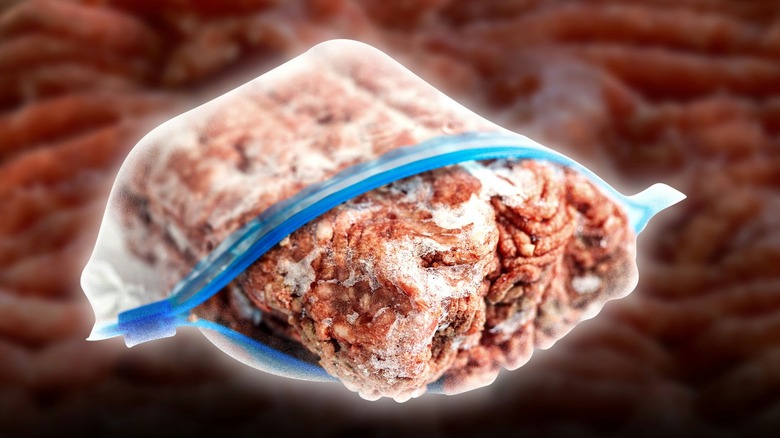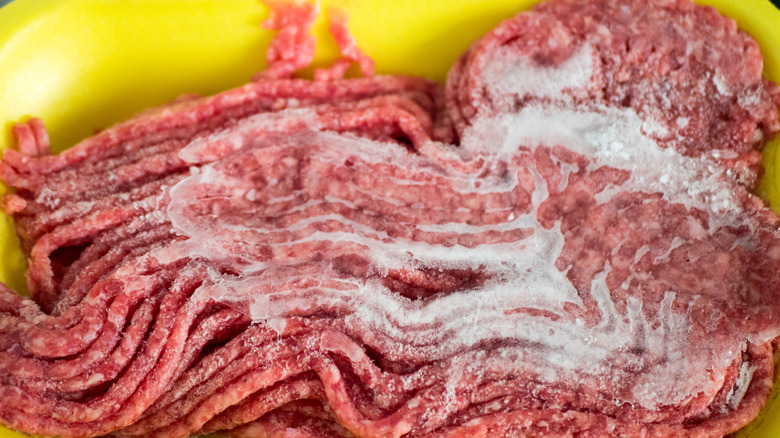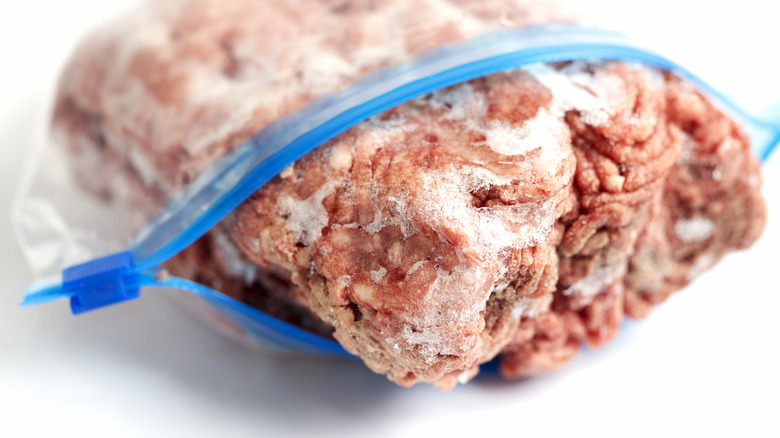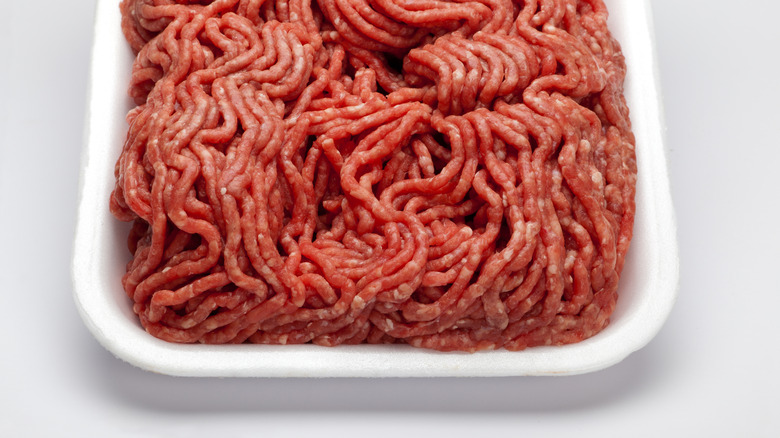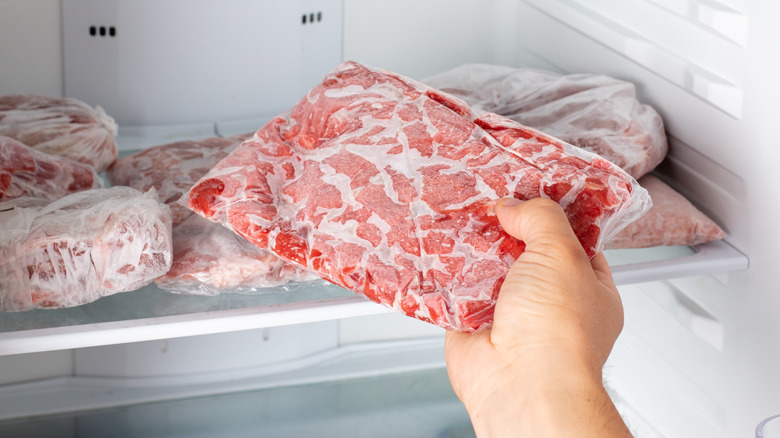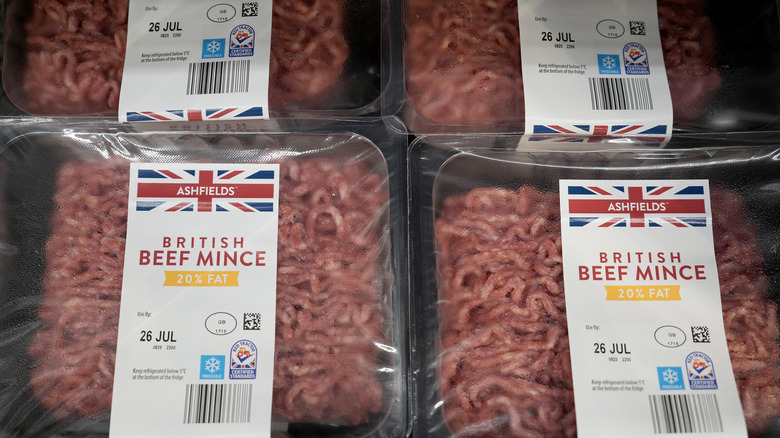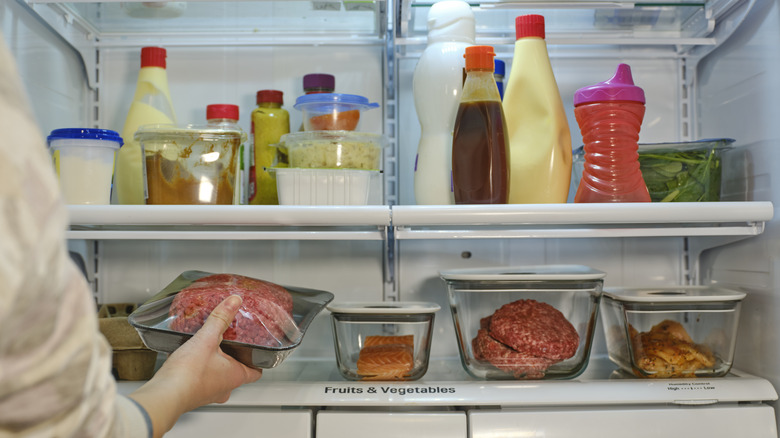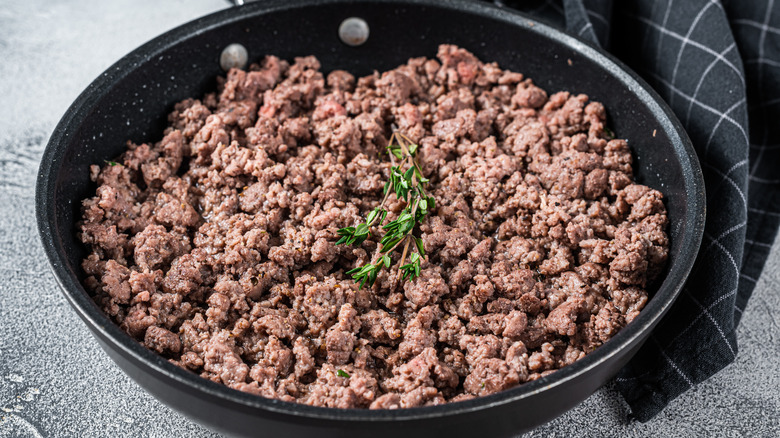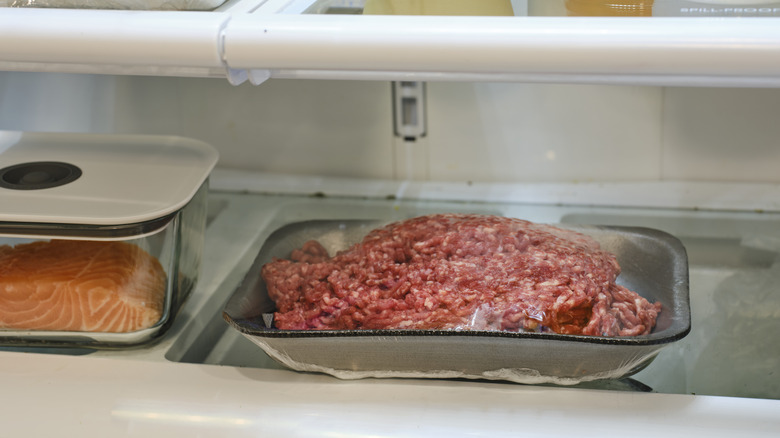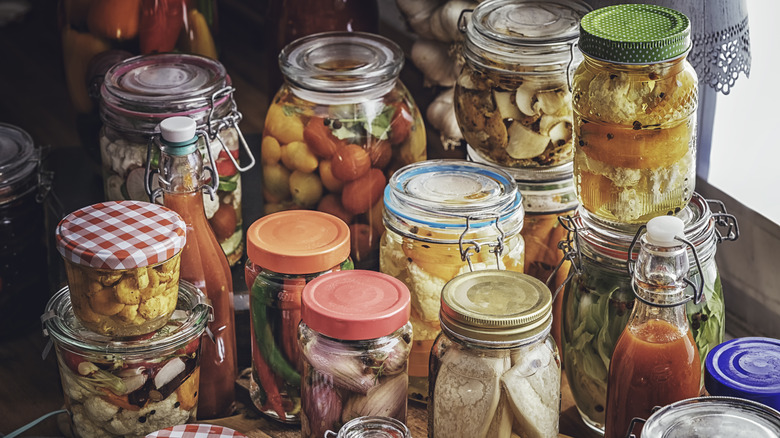Mistakes Everyone Makes Storing Ground Beef
Ground beef is a staple in many American kitchens, and for some cooks, no kitchen is fully stocked without a pound or two ready to go in the fridge or freezer. Given it's a central ingredient in so many family-friendly and budget-friendly favorites, from tasty tacos to all-American cheeseburgers to mighty meatballs and homemade meatloaf, it's no wonder so many of us turn to our trusty stash when it's time to start cooking dinner.
But while the dishes in which ground beef stars are beloved for the wholesome comfort they offer, uncooked ground beef itself can be a minefield if not handled with care. While all meat can harbor bacteria, ground beef is especially susceptible to contamination because the process of grinding exposes more surface area, increasing the chance of cross-contamination. Cooking ground beef thoroughly kills these bugs off, and storing it properly helps keep them from multiplying and causing problems down the road. And while you could just chuck your tray of ground beef straight from your grocery bag into your freezer, there are better and safer ways to handle it. Here are some mistakes to avoid if you want to store ground beef the right way.
Keeping it in the fridge too long
So you've just gotten back from the grocery store and are doing the right thing by getting all your perishables in the refrigerator as quickly as possible. Among the items you're storing away is a package of ground beef, which you plan to use to make burgers when your flaky cousin comes into town later in the week. The problem is he doesn't know exactly what day he'll be arriving — maybe tomorrow, or maybe four or five days from now.
If you're flexible, this won't be a problem for you. But it may become a problem for that package of ground beef stowed in your fridge. Even if you bought it fresh and took care to place it in the coldest part of your refrigerator, as recommended by food-safety experts, ground beef is still highly perishable. To ensure it stays safe — and is at its most appetizing — refrigerated ground beef should be consumed within two days. If you're not sure exactly when you'll be needing it, you're better off storing it in the freezer.
Freezing thick hunks of ground beef
Most of us buy ground beef in 1-pound packages, which we simply toss in the fridge or freezer when we get home. Freezing well-wrapped ground beef in its original wrapping is a workable and convenient method of storage, but once you decide it's time to cook with it, waiting for a thick block of ground beef to thaw out enough to be usable can be a pain. And if food safety is a concern for you (as it should be), you need to thaw your meat slowly in the refrigerator or cold water, not simply take it out of the freezer and put it on the counter. In short, if you're going to cook safely with ground beef, you'll need to do some serious planning. And we all know how good most of us are with that.
You can cut back your thawing time by doing a little preparation before freezing it: Take your meat out of its original wrapping and place it in a large freezer bag. Then press it flat (about ½ inch in thickness). This will not only remove air pockets, thus reducing the risk of freezer burn, but help the meat thaw faster when you decide to cook with it. Seal the bag tightly, squeezing out any air. As a bonus, these flat packets are easier to stack and store in a crowded freezer than a regularly shaped package of ground meat.
Not wrapping it properly before freezing
Home cooks love keeping ground beef in their freezers because it's so dependable — it can, at least in principle, keep indefinitely if solidly frozen, and dishes starring ground beef are almost always family favorites. But freezing anything for extended periods can put its flavor and quality at risk. Freezer burn – the phenomenon in which moisture is drawn out of food and freezes on its surface — can cause the surface of frozen meat to brown and dry out, compromising its flavor and texture. Another risk is that ambient odors from the freezer (or from other frozen foods) can be absorbed into your ground beef, giving it an off flavor.
An easy way to minimize these risks is by taking care to wrap your ground beef properly before freezing it. You have several good options for wrapping, at least one of which you probably already have at home: aluminum foil, plastic wrap, freezer bags, or freezer paper will all do the job. To make your life easier — and keep your freezer more organized — remember to label your wrapped packages of ground beef before storing them, noting the date it was wrapped and frozen and the quantity of ground beef being frozen.
Not dividing up large quantities of ground beef before freezing it
Ground beef is typically sold in packages of a pound or more. But this leaves cooks with a conundrum: If you need only ½ pound of ground beef but all you have on hand is a frozen one-pound slab, what's the best way to proceed? You can thaw the whole thing, cook what you need, and refreeze the rest (according to the USDA, it's safe to refreeze thawed meat, as long as it's been kept refrigerated and hasn't been thawed out for more than two days). But thawing out twice as much meat as you need is time-consuming. Even worse, repeated thawing and refreezing can dry the meat out and compromise its texture.
Your best move is to be prepared. Before freezing your ground beef, divide it into smaller portions. You can weigh out and wrap equal-sized portions (say, ¼ pound) using a kitchen scale. A quicker method is to pre-score a single batch of ground beef into smaller sections before freezing so they can be broken off the frozen block later as needed. To do this, remove a full-sized portion of ground beef from its wrapping, place it in a freezer bag, flatten it with a rolling pin, and using a chopstick or other straight, blunt object, press portion dividing lines into the meat. Then, freeze the meat until you're ready to break off a piece or two.
Keeping it in the freezer too long
Just because you can do something doesn't always mean you should. Ground beef can in theory be frozen indefinitely and still be safe to eat. But safe to eat and appealing to eat are very different things, and the flavor and quality of frozen ground beef will naturally degrade over time. In addition, real-world factors, such as inconsistent freezer temperatures, meat that's been compromised during production or in transit, or exposure of meat to open air, can all degrade the quality and safety of frozen ground beef. In short, while ground beef may well last forever if hermetically sealed and secured in a professionally maintained laboratory freezer, your home freezer — subject to power outages, occasional breakdowns, and of course, family members constantly taking things and out — can't offer the same guarantee.
For this reason, the USDA recommends storing frozen ground beef for no longer than four months if you want to enjoy it at its best. Wrapping your meat securely before freezing it and clearly labeling it with the freezing date will help preserve its quality and remind you to cook and use it in a timely manner.
Not checking the sell-by date before storing ground beef
Another common error many home cooks make is assuming food is at its freshest simply because they just bought it. While a vast majority of the food offered by reputable supermarkets is safe to eat, it's good to bear in mind that stores get supplies of new food constantly, and some products may be fresher than others. So when shopping for ground beef, especially if you plan to store it, be sure to check the sell-by date on the label. While these dates and the criteria for setting them aren't regulated and are there mostly to help retailers ensure quality consistency, they can be a useful way for buyers to gauge freshness.
It's also useful to know that the sell-by date isn't an absolute deadline for food safety — ground beef is still safe to eat up the three days after that date, provided it's been stored properly. So if you have ground beef that's near or just past its sell-by date, it's best to cook and enjoy it as soon as possible — and if you can't, freeze the meat for later. And if you do cook ground beef that's past its sell-by date, take a close look and sniff to ensure it's still fresh enough to eat. Meat that's overly soft, slimy, brown on the outside, or smells off has gone bad and should be tossed.
Forgetting to freeze or refrigerate ground beef immediately
When it comes to keeping ground beef safe, cold temperatures are your friend. While pathogens commonly found in ground beef, such as E. coli, can survive cold temperatures, they don't reproduce as quickly in them. Cold temperatures keep other pathogens from making a home in your ground beef as well. This is why it's important to check the temperature of your ground beef when buying it — it should be unambiguously cold. And once you get it home, it needs to stay cold, either in the refrigerator (if you're planning on using it in the next day or two) or in the freezer.
Just as important for the safety of your ground beef, however, is minimizing the amount of time it's not in a refrigerator or freezer. This means that even if you pass the meat counter as soon as you start your weekly grocery shopping, hold off picking up that package of ground beef until you're almost ready to leave – those extra minutes it's in the supermarket cooler can give you an extra degree of safety. And when you get home, get it out of your car and into your refrigerator or freezer immediately — don't let yourself get distracted and accidentally let it sit at room temperature for hours on end. If this happens, it's best to play it safe and discard it.
Not refrigerating ground beef at a sufficiently low temperature
Ground beef keeps well in the freezer, which is one of the reasons it's a staple in many home kitchens — no matter what else is going on, you can always count on having it on hand for a dinner everyone will like. But once it's out of the freezer, however, the clock starts ticking on its safety and usability. Even if it's kept refrigerated, it'll last only a few days, and that's only if your refrigerator is doing its job.
And for a lot of us, that's a big "if." If your refrigerator is old or not set at a sufficiently low temperature, it may not be keeping your ground beef at its best and safest. It's not enough for the inside of your fridge to feel sort of cool. To keep ground beef fresh and safe, it needs to be close to freezing temperature, around 33 F. So check the temperature setting in your refrigerator — and if you're not sure it's working properly, put a thermometer in the fridge to double-check.
Believing ground beef can only be frozen when raw
While frozen ground beef is great to have on hand, it's not always super convenient to use, especially if you decide to cook with it at the last minute. Defrosting it safely takes time and attention (your microwave or Instant Pot are good options if you need to defrost it in a hurry), and then you need to the time cook it. But if your go-to ground beef recipes are those for dishes such as chili and spaghetti sauce, in which the meat needs to be browned before being combined with other ingredients, you can both speed up the defrosting process and your cooking time by browning your meat before freezing it.
Doing this is simple: Just brown your meat the way you normally would, drain off the fat, cool it in the refrigerator, then freeze it in freezer bags. For maximum versatility, keep seasonings simple with just a bit of salt and pepper; you can add seasonings specific to each recipe later. Not only do the cooked beef crumbles defrost a lot faster than solid chunks of raw ground beef, but in some cases, such as when you're making pasta sauce or chili, you don't even need to defrost it at all: You can just take it from the freezer and dump it into the pot with the other ingredients to heat through.
Storing ground beef in the wrong part of your refrigerator
If you're an enthusiastic home cook or have an active family, your refrigerator can be a busy place: It will be opened and closed dozens of times a day, with different foods being taken out, put in, moved around, and potentially spilled. All of this means the temperature of your refrigerator will fluctuate, with the coldest areas being near the back (furthest from the door and any warm air that may come in when it's opened) and bottom (since cold air tends to sink). However, if you have a refrigerator with a top-mounted ice maker, the top will be colder than the bottom.
This is useful information to know because highly perishable foods such as ground beef should kept as cold as possible. But because raw ground beef can be a source of dangerous pathogens such as E. coli, it's also critical to keep it from potentially contaminating other foods, which can happen if meat juices leak from the package onto other items in your refrigerator. Thus, you should aim to keep your ground beef in a location where it will be both cold and unlikely to drip onto other foods – a bottom shelf or drawer of your refrigerator.
Overlooking the option of canning ground beef
Ground beef is most commonly stored and kept fresh in one of two ways: in the freezer for long-term storage, or in the refrigerator for short-term storage. But there's a third, equally effective way to store ground beef for the long term, which may be of interest to those who are short on freezer space but have experience making their own preserves, pickles, and jams: canning.
Surprising and counterintuitive as it may seem, shelf-stable canned ground beef (or other ground red meat) is indeed a thing. To make it, the ground beef is fully cooked and drained of fat before being placed in sterile canning jars, covered with liquid (water or defatted broth), and sealed. The meat can be seasoned before canning if you like, but bear in mind that some spices (such as thyme) tend to develop overly concentrated flavors when used in canning, so should be avoided. Another critical point to remember is that because ground beef is low in acid, it must be canned in a pressure canner — the more familiar water bath canning method won't get the meat hot enough to be safely preserved.

